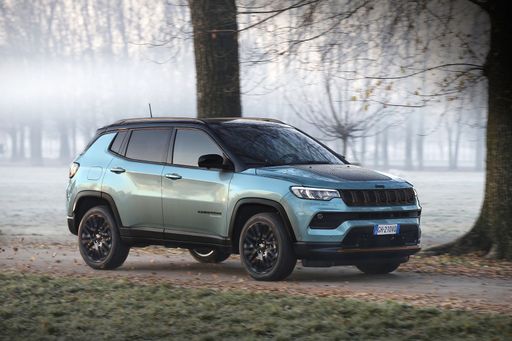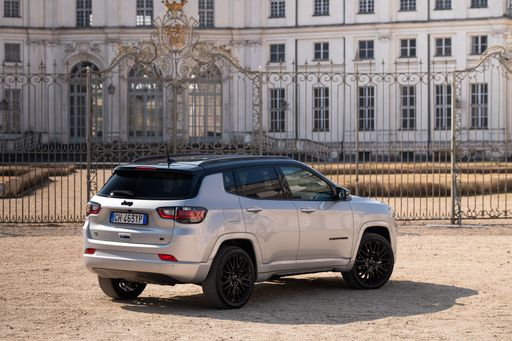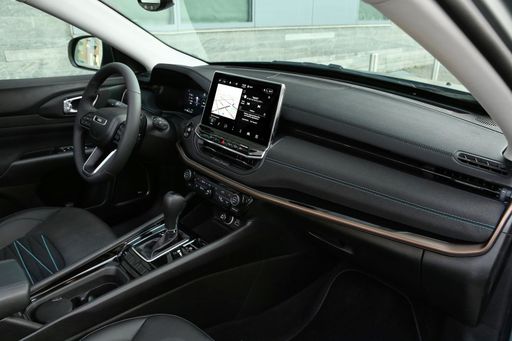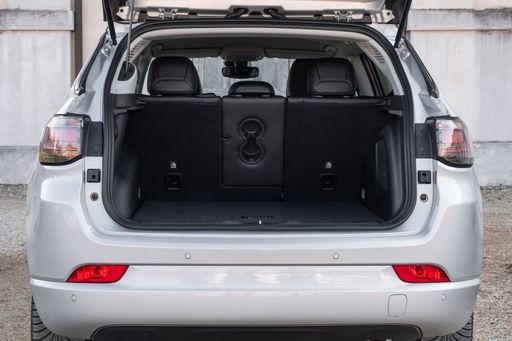Isuzu D-Max vs Jeep Compass – Differences & prices compared
Compare performance, boot space, consumption and price in one view.
Find out now: which car is the better choice for you – Isuzu D-Max or Jeep Compass?
The Isuzu D-Max (Pickup) comes with a Diesel engine and Automatic transmission. In comparison, the Jeep Compass (SUV) features a Petrol MHEV, Plugin Hybrid or Electric engine with Automatic transmission.
When it comes to boot capacity, the Isuzu D-Max offers , while the Jeep Compass provides 550 L – depending on how much space you need. If you’re looking for more power, decide whether the 163 HP of the Isuzu D-Max or the 240 HP of the Jeep Compass suits your needs better.
In terms of consumption, the values are 8.70 L per 100 km for the Isuzu D-Max, and 17.50 kWh2 L for the Jeep Compass.
Price-wise, the Isuzu D-Max starts at 34300 £, while the Jeep Compass is available from 34200 £. Compare all the details and find out which model fits your lifestyle best!
Isuzu D-Max
The Isuzu D-Max stands out in the pickup truck market with its robust design and impressive durability, making it a reliable choice for both work and leisure. Its interior blends practicality with a touch of comfort, featuring user-friendly technology that enhances the driving experience. This vehicle's off-road capabilities and strong performance make it a versatile companion for tackling a variety of terrains.
detailsJeep Compass
The Jeep Compass combines a rugged aesthetic with modern sophistication, making it a standout choice in the compact SUV segment. Its robust design is complemented by a comfortable interior that offers ample space and cutting-edge technology for a seamless driving experience. Whether tackling urban environments or venturing off-road, the Compass provides versatility and reliability, embodying the adventurous spirit synonymous with the Jeep brand.
details @ media.stellantis.com
@ media.stellantis.com
 @ media.stellantis.com
@ media.stellantis.com
 @ media.stellantis.com
@ media.stellantis.com
 @ media.stellantis.com
@ media.stellantis.com
 @ media.stellantis.com
@ media.stellantis.com

|
|
|
|
|
Costs and Consumption |
|
|---|---|
|
Price
34300 - 50100 £
|
Price
34200 - 46900 £
|
|
Consumption L/100km
8.7 - 9 L
|
Consumption L/100km
2 - 5.9 L
|
|
Consumption kWh/100km
-
|
Consumption kWh/100km
17.50 kWh
|
|
Electric Range
-
|
Electric Range
36 - 500 km
|
|
Battery Capacity
-
|
Battery Capacity
74 kWh
|
|
co2
228 - 235 g/km
|
co2
0 - 133 g/km
|
|
Fuel tank capacity
76 L
|
Fuel tank capacity
36 - 55 L
|
Dimensions and Body |
|
|---|---|
|
Body Type
Pickup
|
Body Type
SUV
|
|
Seats
2 - 5
|
Seats
5
|
|
Doors
2 - 4
|
Doors
5
|
|
Curb weight
1905 - 2110 kg
|
Curb weight
1575 - 2198 kg
|
|
Trunk capacity
-
|
Trunk capacity
420 - 550 L
|
|
Length
5280 - 5320 mm
|
Length
4404 - 4552 mm
|
|
Width
1810 - 1870 mm
|
Width
1819 mm
|
|
Height
1770 - 1790 mm
|
Height
1629 - 1675 mm
|
|
Payload
990 - 1095 kg
|
Payload
465 - 470 kg
|
Engine and Performance |
|
|---|---|
|
Engine Type
Diesel
|
Engine Type
Petrol MHEV, Plugin Hybrid, Electric
|
|
Transmission
Automatic
|
Transmission
Automatic
|
|
Transmission Detail
Automatic Gearbox
|
Transmission Detail
Dual-Clutch Automatic, Automatic Gearbox, Reduction Gearbox
|
|
Drive Type
All-Wheel Drive
|
Drive Type
Front-Wheel Drive, All-Wheel Drive
|
|
Power HP
163 HP
|
Power HP
130 - 240 HP
|
|
Acceleration 0-100km/h
12.60 s
|
Acceleration 0-100km/h
7.3 - 10.3 s
|
|
Max Speed
180 km/h
|
Max Speed
180 - 200 km/h
|
|
Torque
360 Nm
|
Torque
230 - 345 Nm
|
|
Number of Cylinders
4
|
Number of Cylinders
4
|
|
Power kW
120 kW
|
Power kW
96 - 177 kW
|
|
Engine capacity
1898 cm3
|
Engine capacity
1199 - 1469 cm3
|
General |
|
|---|---|
|
Model Year
2024 - 2025
|
Model Year
2024 - 2025
|
|
CO2 Efficiency Class
G
|
CO2 Efficiency Class
D, B, A
|
|
Brand
Isuzu
|
Brand
Jeep
|
Isuzu D-Max
The Powerhouse on Wheels: An Overview of the Isuzu D-Max
When it comes to robust and reliable pick-up trucks, the Isuzu D-Max stands out as a formidable contender. With its range of versatile models and a reputation for toughness, the D-Max caters to the needs of both commercial users and off-road adventurers. This article delves into the technical details and innovative features that make the Isuzu D-Max a leader in its class.
Under the Bonnet: Performance and Specifications
At the heart of the Isuzu D-Max lies a 1.9-litre turbocharged diesel engine, producing a power output of 163 PS (120 kW) and a torque of 360 Nm. This robust engine is paired with either a six-speed manual or a six-speed automatic transmission, offering flexibility and control for diverse driving conditions. With a top speed of 180 km/h, the D-Max balances power and performance, making it well-suited for both urban environments and rugged terrains.
Efficiency and Eco-Standards
Fuel efficiency is a pivotal factor for many buyers, and the Isuzu D-Max delivers with a consumption ranging from 8.1 to 9.2 L/100km. Despite its impressive capabilities, the D-Max falls into CO2 efficiency class G, with emissions between 212 and 241 g/km. While this places it towards the higher end of the emissions spectrum, its efficiency is commendable considering its size and power.
Innovative Features and Driver Comfort
Isuzu has integrated numerous innovative features in the D-Max, enhancing both functionality and driver comfort. The pick-up is available in several configurations, including single, space, and double cab options with seating arrangements for 2 to 5 passengers. Equipped with state-of-the-art safety technologies and infotainment systems, the D-Max ensures a comfortable and secure ride. Various trim levels, from L 2WD to V-Cross 4WD Automatik, provide options for different preferences and requirements.
Design and Dimensions
The Isuzu D-Max's design is as practical as it is imposing. Measuring between 5270 mm to 5310 mm in length and 1810 mm to 1870 mm in width, with a height of 1770 mm to 1790 mm, it offers a commanding road presence. Its substantial payload capacity ranges from 995 kg to an impressive 1130 kg, making it an ideal choice for heavy-duty operations.
Pricing and Market Position
The Isuzu D-Max is competitively priced within the range of 35,765€ to 56,765€, illustrating its value proposition in the pick-up truck market. It caters to varied customer needs with an extensive line-up and competitive pricing, thereby solidifying its position as a top choice for those seeking a reliable and durable pick-up.
Conclusion: A Vehicle Built for Versatility
The Isuzu D-Max is more than just a workhorse; it is a testament to engineering capable of blending power, practicality, and innovation. Its enduring appeal lies in its versatility and robust performance, making it a popular choice across different demographics and industries.
Jeep Compass
Exploring the Jeep Compass: A Modern SUV with Innovative Features
The Jeep Compass continues to challenge the boundaries of what an SUV can be, offering a blend of practicality, efficiency, and rugged appeal. This model, distinguished by its diverse range of powertrains, promises to cater to various needs and preferences. From urban commuting to exploring off-road trails, the Compass delivers with aplomb.
Engine Versatility and Performance
Under the bonnet, the Jeep Compass offers a diverse lineup of engines designed to meet varying driver demands. With options ranging from mild hybrid petrol engines to advanced Plug-in Hybrid Electric Vehicles (PHEVs), the Compass provides both efficiency and power. This impressive engine choice results in power outputs from 130 to 240 PS, ensuring that there is a model suitable for both city driving and more ambitious off-road excursions.
Performance devotees will appreciate the Compass's quick acceleration, clocking 0-100 km/h in as little as 7.3 seconds. Meanwhile, fuel economy remains commendable, with consumption figures between 1.7 to 5.5 litres per 100 kilometres, making the Compass an economical choice for daily driving.
Innovative Hybrid Technology
The Jeep Compass brings cutting-edge hybrid technology to the forefront. The available plug-in hybrid variants offer electric-only driving ranges of up to 53 kilometres, ideal for environmentally conscious urban drivers. This zero-emission capability makes short trips sustainable without compromising on the flexibility offered by the internal combustion engine for longer journeys.
Dynamic Drivetrain Options
One of the main talking points of the Compass is its adaptable drivetrain options, which include both front-wheel drive and all-wheel drive systems. The 4xe PHEV models particularly stand out with their all-wheel drive, providing enhanced stability and traction suitable for varying terrains. Additionally, the automated transmission ensures smooth gear changes and an overall comfortable driving experience.
Design and Comfort
Beyond performance, the Jeep Compass excels in providing a stylish and functional environment. The SUV's dimensions, ranging between 4398 to 4404 mm in length and up to 1874 mm in width, offer ample interior space for both passengers and cargo. The boot space varies from 420 to 438 litres, accommodating the needs of families and adventure-seekers alike.
With seating for five, maximum comfort is assured, thanks to high-quality materials and thoughtfully designed interiors. The Compass integrates advanced technology seamlessly into its cabin, ensuring easy connectivity and an engaging driving experience.
Safety and Efficiency
Safety is paramount in the Jeep Compass, with a range of driver assistance features providing peace of mind. The model adheres to impressive CO2 efficiency standards, boasting a CO2 emission range between 37 and 123 g/km, making it both a responsible and reliable choice.
Furthermore, the Compass offers competitive running costs, with monthly expenses ranging from €1,095 to €1,315, and an average cost per kilometre between 43.8 and 52.6 cents. This cost-effectiveness further underscores the Compass’s value proposition.
Conclusion
Overall, the Jeep Compass stands out as a richly equipped, versatile SUV, ready to tackle urban or off-road challenges. With its blend of powertrain innovations, superior performance, and sophisticated design, it redefines what’s possible in the SUV segment. Whether for efficient city driving or adventurous journeys into the unknown, the Compass is ready to rise to the occasion.
Which drive types are available for the Isuzu D-Max?
Available as All-Wheel Drive.
The prices and data displayed are estimates based on German list prices and may vary by country. This information is not legally binding.
